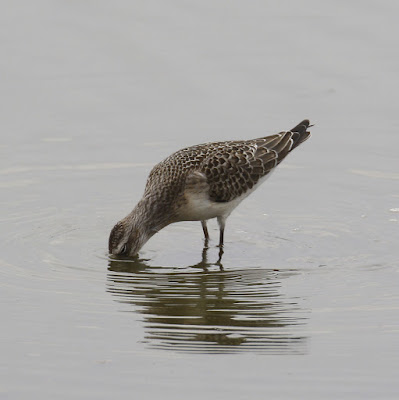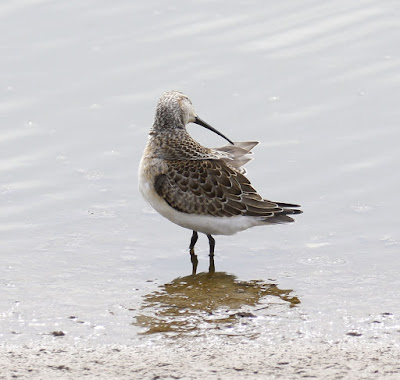Reports over these last two weeks have been coming in of large numbers of Curlew Sandpipers appearing at various locations, mainly on the east side of Great Britain and none more so than at the RSPB's Frampton Marsh Reserve near Boston in Lincolnshire.
I am not sure what the record count for Curlew Sandpipers is at one location in Britain but the two hundred and fifty eight recorded a week or so ago at Frampton is surely up there with the best. Normally they only get between twenty to forty maximum per year. I planned a trip today to go and see them although numbers had declined to between one hundred and one hundred and fifty, which is still pretty good as far as I am concerned.
Additionally there were also up to ten Little Stints present, so a bit of a wader fest looked to be on the cards for my visit.
Curlew Sandpipers are a long distance migrant breeding on the tundra of northern and northeast Siberia and migrating to western and southern Africa, southeast Asia and Australasia. The birds at Frampton are on their way to Africa. Why there are such numbers this year is open to conjecture but success on their breeding grounds very much depends on lemmings. A good breeding year for lemmings means that the young Curlew Sandpipers are less predated by the likes of skuas, owls and foxes which concentrate on the lemmings and consequently there are more Curlew Sandpipers surviving to migrate south. The annual lemming breeding success is cyclical with a good year about every three to four years so presumably the lemmings had a successful breeding season this year. Weather conditions good or bad on the tundra can also have a major effect on breeding success and large numbers of juveniles can also be displaced to Britain by easterly winds, as they usually migrate to the east of Britain. The adults migrate before the juveniles and at Frampton, on this visit, I did not see one adult but only juveniles.
In appearance they are an elegant small wader of eye pleasing proportions.Not much bigger than a Dunlin with which they often associate, they look larger due to their longer downcurved bill and longer legs, also looking slimmer due to their more attenuated bodies. The Dunlin in direct comparison looks diminished in their presence, dumpy and slightly squat on its shorter legs and with shorter bill.
The plumage of juvenile Curlew Sandpipers is also less messy than that of a Dunlin. The upperparts are neatly scaled overall with white feather fringes and there is a delicate peachy flush to the breast and fore flanks with the rest of the underparts pure white. In flight they show an unmarked broad and square white rump patch and this can be very distinctive when they are seen flying away.
So at 7am I collected Ed from Bloxham and we commenced a somewhat tortuous route, courtesy of the Satnav, to Frampton, arriving three hours later at 10am in the car park by the RSPB's Visitor Centre
 |
| The RSPB's Visitor Centre at Frampton Marsh |
The reserve was thankfully fairly deserted today and we made our way to the 360 Hide along a path brightened by a huge strip of Sunflowers running alongside.
Once in the hide it did not take long to find our first Curlew Sandpipers, feeding amongst the many Dunlin in the channels of water or along the areas of still wet mud. The last time I was here, earlier in the year it was much wetter but much of the mud has now dried so the birds on one side of the hide were a little distant in the channels of water left but on the other side the water was closer, so moving to the other side of the hide we got good close views of the Curlew Sandpipers.




Little Stints were a little harder to locate as there were only a few of them but both Ed and myself found our own, running about rapidly amongst the Dunlin. They too were juveniles and in the end we located four. The Curlew Sandpipers were literally everywhere you looked, singly or in little groups and I noticed that due to their longer legs they could wade deeper into the water than the Dunlins, thrusting their entire bill below water to probe the hidden mud and wading in the water up to their bellies. Others probed deep into the mud with their long decurved bill often getting lumps of sticky mud stuck to their bill and making them look not quite so elegant
The white supercilium of the juvenile Curlew Sandpipers was also another good characteristic to look for when identifying them but frankly they looked so different to the masses of Dunlin that it was not a difficult task to separate them.
Dunlin and Ringed Plover were also here in large numbers and were the commonest small waders present. In amongst them were a few Ruff, both pale grey adults and brown juveniles. Avocets, Common Redshank, Common Greenshank and Common Snipe were also identified from the Hide together with the first returning Wigeon. It was invigorating to just sit here and watch the hordes of waders going about their lives, a constantly changing panoply of activity as various alarms took them all up into the skies only to descend back on the mud and continue feeding or just standing about.
We moved on to the second Hide located a little way further down the track and overlooking a large scrape covered by mainly Black tailed Godwits.
 |
| Ed in a deserted Hide watching Black tailed Godwits |
We estimated that there were around two thousand standing in close formation in three distinct groups and keeping up a constant bickering amongst themselves.They were in all varieties of plumage, some still in their barred rusty orange breeding finery, many already in their grey brown winter plumage and a smattering of dull orange juveniles amongst them, looking fresh and a little gawky as is often the case with juveniles.
 |
| Flocks of mainly Black tailed Godits |
In amongst the godwits were other waders including Golden Plover still in their summer plumage of black bellies and spangled golden upperparts, some Knot already in their grey winter plumage and a Common Greenshank and a Common Redshank. We sat in the hide and enjoyed this spectacle of massed waders for half an hour or so and then moved on, deciding to walk round the perimeter of the reserve by traversing the stony track through the reeds and grassy fields to some steps leading up to a raised bund and then taking the path along the bund. We looked out to our right across the muddy scrapes of the reserve and off to our left across a huge area of saltmarsh that ultimately led to the seashore and The Wash.
 |
| The Bund with saltmarsh to the left and scrapes to the right |
 |
| Wader scrapes |
There were birds scattered all over the scrapes. Yet more Curlew Sandpipers, Dunlins, Ringed Plovers, Little Egrets in snow white clusters and a huddle of seven Little Grebes sheltering in a secluded area of shallow water. A Little Ringed Plover called and we found it running along the muddy edge of another small flash of water and shortly after it was joined by another, before both flew off into the hinterland of scrapes and flashes. We weaved our way through some cows that were sitting on the track chewing the cud, their teeth grinding as they did so, their breath coming in snorts of indignation at our intrusion and then we went through another gate that would lead us back by another path to where we had begun at 360 Hide. A young Yellow Wagtail ran before us down the path and then sought sanctuary on the wooden fence rail before flying off across the reserve. Another area of pools and a shallow muddy stream bordering a field holding some inquisitive cows had attracted a few Yellow Wagtails to run the gauntlet of the cow's hooves in search of insects, and also attracted an inevitable complement of a dozen Curlew Sandpipers to the pools, which we stopped to admire wondering when such an opportunity would arise again.
Time was moving on. Ed needed to be back at Bloxham by late afternoon for rugby training so we rounded off the day where we had begun, in the 360 Hide watching Ringed Plovers, Curlew Sandpipers and a Little Stint plus all the other waders we had seen earlier. One or two Curlew Sandpipers came close to the Hide and I watched one standing thigh deep in the water preening elegantly.
 |
| Juvenile Ringed Plover |
 |
| Curlew Sandpiper and Ringed Plover - both juveniles |
A fully grown juvenile Avocet, well able to look after itself was still being vigorously defended by its over enthusiastic parent which would fly at any Mallards coming remotely close, driving the startled ducks off with some vehemence and persistence.
 |
| Juvenile Avocet |
 |
| Aggressive Avocet parent |
As we left the hide a Peregrine flew over the scrapes in spiralling flight setting all the waders off into a frenzy of agitated, co-ordinated airborne motion. Back at the tiny Visitor Centre we checked the board for today's sightings and found that a Spotted Flycatcher, a Common Redstart and a Lesser Whitethroat had been seen earlier. We found all bar the flycatcher in the hedgerows alongside the approach road to the reserve just as a light rain shower commenced. This was our cue to depart after another very pleasing day of birding.































it's a fantastic reserve which keeps getting better,
ReplyDeletenot bad seeing it's only seven years old!!!
I was there after the birdfair on the 19th. it's a place I've visited often over the past few years. The 360 hide in particular gives great close views of many species. On that day there were "only" around 100 curlew sands and 4 little stints! Add in spot shank, goldies, ruff and others including 3 spoonbill and it made for a great afternoon.
ReplyDelete